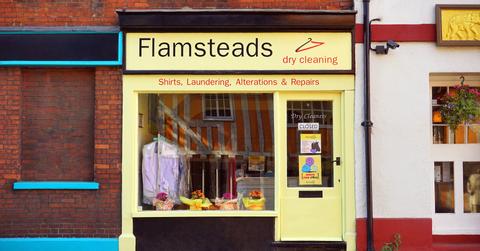New To Shopping Organic? Here's What Every Green Shopper Needs To Know
In our efforts to live more sustainable, environmentally-friendly lives, it's tempting to shop for "organic" products whenever we can. But navigating what labels like "organic," "natural," or "eco-friendly" actually mean can be tricky.
Updated May 26 2019, 5:12 p.m. ET
From cleaning supplies and food to bed sheets and cleanses, the halls of big-box stores and the pages of Amazon are flooded with products claiming to be “organic” and eco-friendly.
Greenwashing—making a product appear more eco-friendly than it actually may be—is big business. A company that so much as mentions green/organic/eco-friendly on its label can drive sales and command bigger profits. But it’s very hard to tell what’s real and what’s hype. Unfortunately, not all "organic" or "sustainable" products live up to their labels, which is why it's always important to do your research before making a purchase, big or small.
When it comes to food, labeling something “organic” generally comes with a series of inspections and certifications. But any organization granting said certifications are being paid by the very companies seeking the certification, raising the potential for corruption.
The further outside the country you get, the less you can trust that labeling system; and when you broaden the scope to include all products, the laws become increasingly murky until they sometimes disappear altogether. Calling something non-toxic, all natural, or even organic doesn’t necessarily require a company to do anything special by way of proof. According to the USDA, all organic actually means is:
“Organic is a labeling term that indicates that the food or other agricultural product has been produced through approved methods. These methods integrate cultural, biological, and mechanical practices that foster cycling of resources, promote ecological balance, and conserve biodiversity. Synthetic fertilizers, sewage sludge, irradiation, and genetic engineering may not be used.”
In 2012, the Federal Trade Commission made the first updates to its “FTC Green Guides” since 1998. Originally published in 1992, the document outlines standards for certain packaging claims. The trouble is, these guides are too vague to be compelling. For example: To be labeled as compostable, a product must “break down into, or otherwise become part of, usable compost” in a “safe and timely manner," i.e., in approximately the same time as the materials with which it is composted.
Organic dry cleaners
This may not seem like a tricky situation at first, since cleaners can be notorious for hosing down clothing with toxic chemicals and then sending you home with them to cover your skin with. Who wouldn’t want to take their clothing to an eco-friendly dry cleaner? Well, for starters, organic dry cleaners can actually use almost all of the same chemicals as regular cleaners—including perchloroethylene (“perc”), a solvent all cleaners (organic or not) are required to phase out nationwide by 2020.
The reason “organic” dry cleaners can use chemicals like perc is because dry cleaners aren’t FDA-regulated in the same ways as, say farms, and because these solvents contain one thing that is very, very organic: carbon. That makes these solvents organic by technicality.
But let’s assume an organic dry cleaner doesn’t use perc, because definitely not all do. Instead, they may use GreenEarth Cleaning (a patented, decomposable solvent), carbon dioxide cleaning (liquefied C02 is used as a cleaning solvent, then converted back to gas), or hydrocarbon cleaning (chemically similar to perc, but less hazardous). While this is awesome, generally speaking, all of these methods will be reflected in your dry-cleaning bill. If you have the resources and time, it's likely just as eco-conscious to do your dry cleaning at home, but of course, everyone's needs are different.
‘Green’ cleaning products
The Environmental Working Group looked into at 2,000 common cleaning products and discovered a gross lack of federal oversight, hidden information about what these cleaners contain, and hardly any complete lists of ingredients. With the average American dropping $42 a month on cleaning supplies, that’s all kinds of harmful toxins—many of which come to you in packaging saying “organic.”
Make your own for a fraction of the cost here.
Organic beauty products
Our skin absorbs 60 percent of what is put on it. And with women putting, on average, 515 synthetic materials on their skin daily, that’s all kinds of mysterious chemicals. In particular, beauty products are questionable beasts since the FDA doesn’t require pre-market testing for those.
Without that testing, it’s relatively easy for any makeup company to make any claims it likes—including organic, all-natural, or biodegradable. While that sometimes results in lawsuits, there’s no real way to tell what’s marketing and what’s true when it comes to beauty products.
The best advice here is to buy products like soaps and lotions as locally as you can find them (local farms often have items like goats milk- and beeswax-based soaps, for example), and to limit the amount of beauty products you use in the first place. If you still want some good stuff for fancy evenings out, be sure you’re going with reputable brands.
Organic juice cleanses and detoxes
While we'd all love to believe there's a magical smoothie out there that can undo the damage we sometimes do to our bodies, good health doesn’t actually come in a total colon cleanse or body detox.
There is no magical tincture that will magically cleanse or detoxify your body. What "healthy" involves is different for every person, but living a healthy life definitely involves long-term actions and decisions that treat your body with care and nourishment.
To live more eco-friendly and organically, do just one thing
Amidst all the marketing you’re bombarded with on a daily basis, the bottom line of environmentalism relies on one very basic tenet. The best way to be eco-friendly isn’t to buy organic—it’s to use less. And when you do buy, do your research, first!
